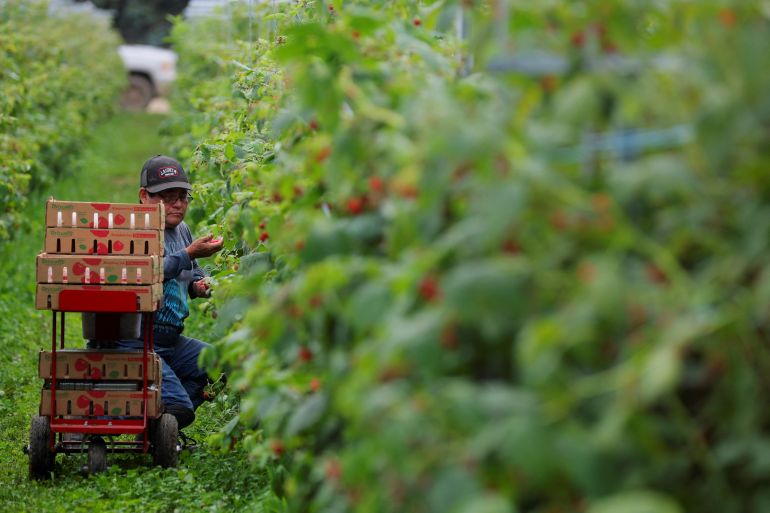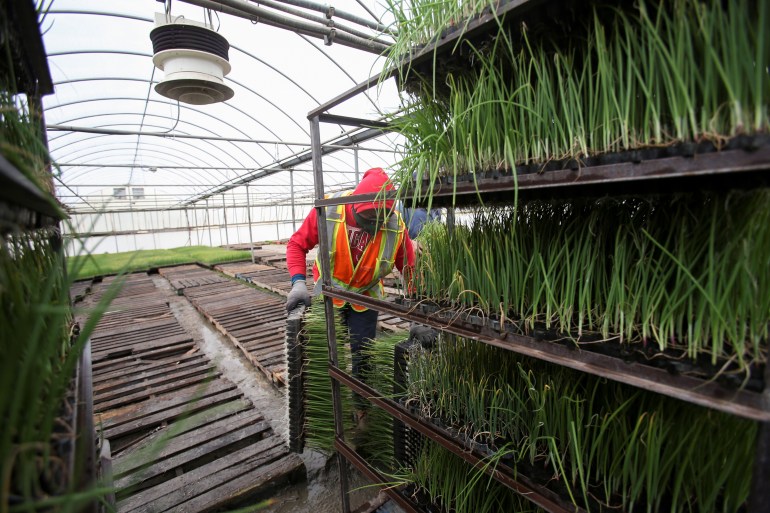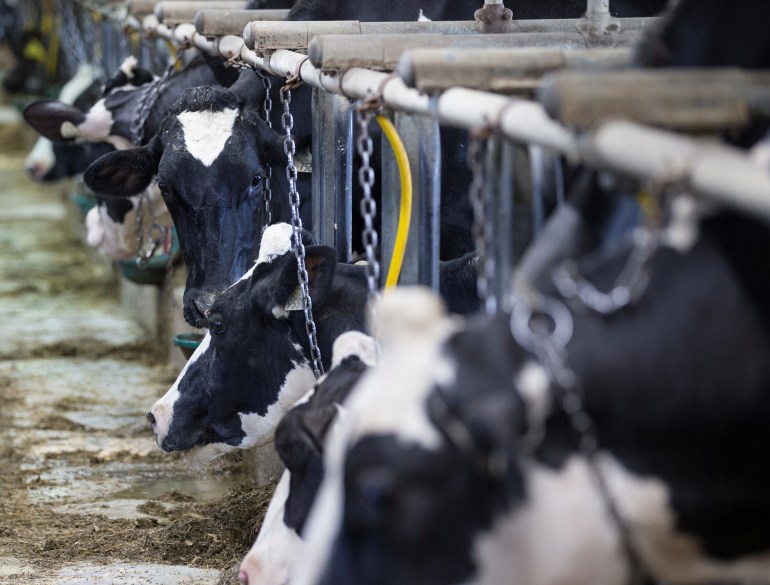‘Overtly racist’: Lawsuit challenges Canada’s migrant farmworker system
Canada’s half-a-century policy of tying migrant workers to their employers denounced as modern-day slavery.

Montreal, Canada – “It would be contrary to the whole Canadian belief in freedom of the individual.”
The year was 1952, and Canada’s then-minister of immigration, Walter Harris, was rebuffing the idea of tying immigrant farmworkers from Europe to their Canadian employers.
Keep reading
list of 3 itemsAmid food shortage fears, will Italy legalise migrant workers?
Lebanon blast: Why can’t migrant workers go home?
“It would, of course, be possible to take steps which would ensure that the man who says he is coming to Canada as a farm worker remains a farm worker. We could even hold the possibility of deportation over his head,” Harris said.
“However, it is my opinion that the Canadian people would be entirely opposed to any such practice.”
Fifteen years later, however, government officials were singing a different tune. Continuing to face labour shortages in the agricultural sector, Canada began bringing in Black and Indo-Caribbean seasonal farmworkers.
But unlike their European counterparts, these Black and brown field-hands were to be inextricably tied to their specific employers, a rule that remains at the heart of Canada’s migrant agricultural worker programmes today.
Experts and rights advocates say the setup undermines the workers’ ability to organise or demand better wages and conditions; prevents them from leaving abusive workplaces; makes them vulnerable to exploitation; requires them to pay into an unemployment insurance scheme that they cannot access; and opens them up to reprisals, including deportation, if they speak out.
Now, a proposed class-action lawsuit (PDF) has shone a spotlight on the “racist and discriminatory” origins of so-called tied employment in these schemes. The suit alleges that Canada’s migrant worker programmes violate the country’s constitution, formally known as the Canadian Charter of Rights and Freedoms.
“The reason why these strict conditions were imposed [was] overtly racist,” said Louis Century, a lawyer involved in the suit, which is seeking 500 million Canadian dollars ($371m) in damages.
“The government has to account for and reckon with the fact that the policy that it continues to impose more than 50 years later was implemented for racist reasons,” he told Al Jazeera. “It’s caused harm to generations of racialised workers, and it has to end.”
The system
Canada launched the Seasonal Agricultural Worker Program, or SAWP, in 1966 as part of a bilateral agreement with Jamaica. More than 260 Jamaican workers travelled to Canada in that first year to fill gaps in the agricultural sector.
Hyacinth Simpson, an associate English professor at Toronto Metropolitan University, explained that prior to that, non-white immigration to Canada was “highly controlled”.
This was because “Black and Asian peoples particularly were considered undesirable, unassimilable, and unlikely to bring any benefits to the country – economic or otherwise,” Simpson, a postcolonial scholar, told Al Jazeera in an email.
“For the most part, when ‘undesirables’ were admitted in relatively large numbers, it was via federally sponsored labour programs in which the migrants were employed temporarily or seasonally so that Canada benefited from their labour without having to assume the same kind of responsibility for them as for citizens.”
Since its creation in the 1960s, the worker programme has been expanded to include Mexico and 10 other countries in the Caribbean. In 2022, more than 70,000 temporary foreign workers laboured in Canada’s agricultural and agri-food sectors through SAWP and other agricultural programmes.
The workers pick fruits and vegetables on Canadian farms, work at meat-processing plants, and serve as the backbone of an industry now worth hundreds of billions of dollars. Under SAWP, foreign workers can work in Canada for up to eight months in a single year, and it is not uncommon to find migrants who have been shuffling back and forth between their home country and Canada for decades.
Within this system, tied employment practices are a “tried and true way” of maintaining a power imbalance between employer and employees, Simpson added. This includes tying farmworkers to specific farms or employers, preventing them from changing jobs, and even busing workers between their residences and grocery stores.
“The cumulative effect is to marginalize and isolate the farmworkers in Canadian spaces and keep them separate from all things Canadian,” she said.

‘Treated like mules’
Indeed, for nearly as long as these schemes have existed, workers have reported mistreatment.
Foreign workers have been forced to live in crowded, substandard housing and work long hours in unsafe conditions for low wages. Many say they fear being deported or barred from coming back to Canada for the next season if they raise concerns with their employers.
Chris Ramsaroop, an activist with the group Justicia for Migrant Workers (J4MW), described Canada’s system as one that “treats Black and Brown workers from the Global South different than Canadian workers”.
By way of example, he noted that employers can terminate migrant agricultural workers’ contracts early if a frost, or another extreme weather event, hits Canadian crops and they are no longer needed.
“Rather than trying to compensate the workers like somebody else in Canada who faces similar conditions, we simply send workers home,” Ramsaroop told Al Jazeera.
“The way that the system is set up works against the interest of migrant agricultural workers,” he added. “This is designed.”
In 2022, a group of Jamaican farmworkers publicly denounced their mistreatment on farms in Ontario, saying they were “treated like mules” and faced threats and abuse, both physical and verbal. The conditions, they said, were akin to “systematic slavery”.
That was echoed about a year later by a United Nations expert, who described Canada’s system as “a breeding ground for contemporary forms of slavery”.
The UN special rapporteur, Tomoya Obokata, said last September that “employer-specific work permit regimes” were especially dangerous, making “migrant workers vulnerable to contemporary forms of slavery, as they cannot report abuses without fear of deportation”.
Employment insurance
Kevin Palmer understands that fear. In 2014, he left his native Jamaica on a SAWP contract and arrived at a greenhouse in the small town of Leamington, Ontario – the self-proclaimed “greenhouse capital of Canada”.
“We lived on the greenhouse,” the 42-year-old told Al Jazeera in a phone interview in late January. “We were sleeping on a bunk bed, with two guys – one upstairs, one downstairs. It was like 12 of us, so six [bunk] beds were in the room.”
The tasks were gruelling – long hours spent tending to crops and harvesting vegetables – and Palmer said he often was working against the clock to meet his daily quotas. But the father of two said he never lost sight of his goal: making money to help his family “live a better life for the future”.
Yet after six agricultural seasons in Canada, his contract was abruptly terminated in 2019, and he was sent home to Jamaica. Palmer was left with little recourse and no explanation as to why he was sacked, he said, and he has not been able to work in Canada since.
He also never got access to Employment Insurance (EI) when he was forced to leave Canada, despite paying into the programme. “They [drew] a lot of money from us,” said Palmer, who is one of two named plaintiffs in the class-action lawsuit.
The claim alleges that tied employment excludes migrant agricultural workers from accessing EI benefits in Canada – another violation of the Charter. This is because, to access EI, workers need to be in the country and open to other work, among other requirements.
They “are required to pay EI premiums, and by virtue of the mandatory tied employment provision, are necessarily precluded from ever receiving regular benefits”, the lawsuit states.
Migrant workers employed under SAWP and the Temporary Foreign Workers Program’s agricultural stream paid more than 470 million Canadian dollars ($350m) in EI premiums since 2008, according to the claim.
“I don’t know if we were entitled to get back [that] money,” Palmer said.

‘Countless injustices’
Employment and Social Development Canada, the country’s federal labour ministry, told Al Jazeera that it could not comment on matters before the courts.
But the department said in an emailed statement that Canada “takes its responsibilities with respect to the protection of temporary foreign workers very seriously”.
It noted that the government introduced an open work permit in 2019 to allow “vulnerable workers” to leave abusive situations. Canada also maintains a confidential tip line to allow temporary foreign workers to report abuse and is working to “improve the quality of employer inspections”.
“Employer-specific work permits”, the department said, are an “important feature” of Canada’s temporary foreign worker programmes because they allow Ottawa to know “which employers are employing temporary foreign workers at any given time and at what locations they are working”.
But according to Century, the class-action lawyer, this employment model remains the source of “countless injustices”.
“It makes them more vulnerable. It deprives them of the freedom to leave a difficult situation and seek work elsewhere, and … it has the effect of depriving them of significant EI benefits that ordinary workers would otherwise have access to,” Century said.
Century said the lawsuit is still in the early stages. A certification hearing is expected in the coming year to determine whether it can move forward. If it does, every current or former migrant farmworker who worked in Canada over the last 15 years would be considered part of the class.
“[This is] only the first step of reckoning with the racist legacy” of this programme, Century added.
“Ending tied employment today doesn’t cure the harm it has caused to generations of workers over the past 50-plus years. But at a bare minimum, it stops perpetuating that harm.”